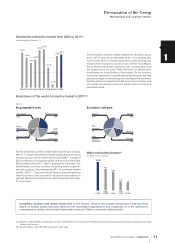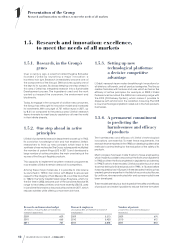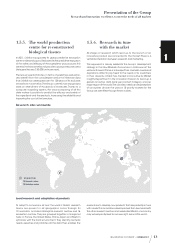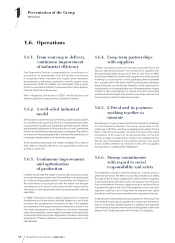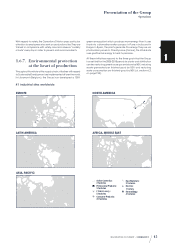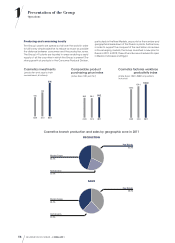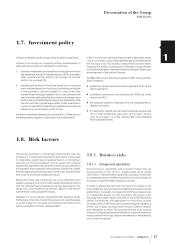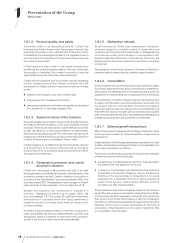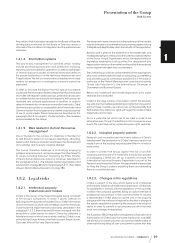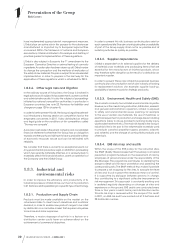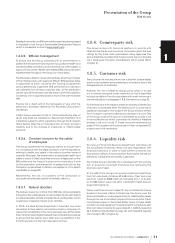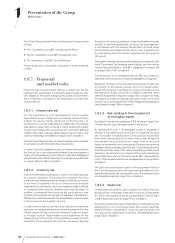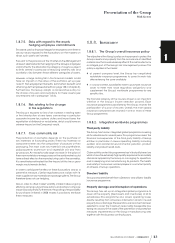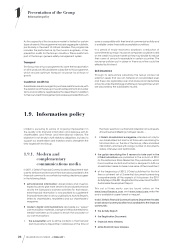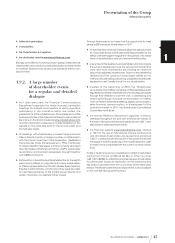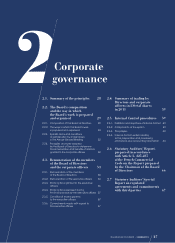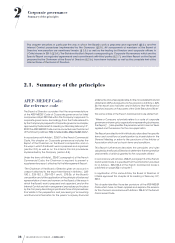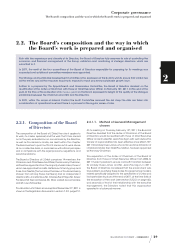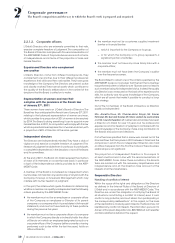Loreal 2011 Annual Report Download - page 23
Download and view the complete annual report
Please find page 23 of the 2011 Loreal annual report below. You can navigate through the pages in the report by either clicking on the pages listed below, or by using the keyword search tool below to find specific information within the annual report.
21REGISTRATION DOCUMENT − L’ORÉAL 2011
Presentation oftheGroup
1
Risk factors
Detailed information on EHS risks and the way they are managed
is available in the Group’s Sustainable Development Report
which is accessible on-line at www.loreal.com.
1.8.3.5. EHS risk management
To ensure that the Group complies with its commitments to
protect the environment and improve occupational health and
industrial safety conditions, and to achieve concrete targets, a
rigorous Environment, Health and Safety (EHS) policy has been
implemented throughout the Group for many years.
The Operations Division issues Internal Rules fixing the principles
of the L’Oréal policy with regard to EHS. An EHS representative
is appointed at each industrial site. Training programmes
are systematically organised. EHS performance indicators
are collected from all the production sites, all the distribution
centres and all the research centres every month. The collection
is carried out on a quarterly basis for most of the administrative
sites.
The fire risk is dealt with in the framework of very strict fire
prevention standards (National Fire Protection Association
standards).
L’Oréal Group operates a total of 115manufacturing sites, of
which only three are classified as “Seveso high threshold” and
is therefore subject to strict regulations through the European
Union Seveso Directive on the prevention of major accident
hazards due to the storage of chemicals or inflammable
products.
1.8.3.6. Constant concern for the safety
ofemployees
The Group implements the necessary means to ensure that it
is in compliance with the legal provisions and the regulations
relating to health and safety in the various countries where it
operates. Moreover, the preservation of employee health and
safety is one of L’Oréal’s priorities and is an integral part of the
EHS policy and the Group’s human and social policy. It rests
on the evaluation and prevention of professional risks in the
Company as described in detail in paragraph6.1.2.4.
Health
and Safety
on page190.
Nevertheless, the risk of accidents at the workplace or
occupational diseases cannot be entirely ruled out.
1.8.3.7. Natural disasters
The Group’s presence at more than 300sites (shop excluded)
throughout the world exposes it in some areas to risks with regard
to natural disasters, climate uncertainties or earthquakes, which
could have a negative impact on its activities.
In2010, the Real Estate Department classified countries
according to their seismic risk and launched a campaign to
assess the vulnerability of the most exposed sites. At the same
time, the Information Systems Department initiated a procedure
to ensure that the seismic risk is taken into consideration in the
IT continuity plans of the most exposed countries.
1.8.4. Counterparty risk
The Group enters into financial relations in priority with
international banks and insurance companies given the best
ratings by the three main specialised rating agencies. The
Group therefore considers that its exposure to the counterparty
risk is weak (see note24.4.
Counterparty risk
on page135 in
chapter4 ).
1.8.5. Customer risk
The customer risk may result from non-collection of receivables
due to cash problems encountered by customers or due to the
disappearance of customers.
However, this risk is limited by Group policy which is to take
out customer insurance cover inasmuch as this is permitted
by local conditions. The risk associated with credit insurance is
mentioned below in paragraph1.8.8.
Insurance
on page23.
Furthermore, due to the large number and variety of distribution
channels at worldwide level, the likelihood of occurrence of
significant damage on the scale of the Group remains limited.
The 10largest customers/distributors represent around 18%
of the Group’s sales. The amount considered as posing a risk
of non-collection for which a provision for liability is therefore
booked is set out in note17
Trade accounts receivable
on
page119 in chapter4 of this document. It does not exceed 2%
of gross accounts receivable.
1.8.6. Liquidity risk
The Group’s Financial Services Department centralises all
the subsidiaries’ financing needs and also negotiations with
financial institutions in order to have better command over
financing conditions. Any transactions that may be carried out
directly by subsidiaries are closely supervised.
The L’Oréal Group’s liquidity risk is managed with the primary
aim of ensuring continued financing and optimising the
financial cost of debt.
To this effect, the Group has unused confirmed credit lines
from first-rate banks totalling €2,438million. Their terms are
less than 1year for €588million and ranging from1 to4 years
for €1,850million (see note23.9.
Confirmed Credit lines
on
page132 chapter4 ).
These credit lines are not subject to any conditionality clause
based on financial criteria. Furthermore, the Group uses the
financial markets, on a very regular basis, to meet liquidity needs
through the use of short-term papers in France and short-term
commercial paper in the United States. None of these debts
contains an early repayment clause linked to compliance with
financial ratios (covenants) (see notes23.1.
Debt by type
and
23.2.
Debt by maturity
date on page131 and note24.5.
Liquidity
risk
on page135in chapter4 ).


